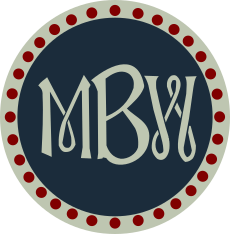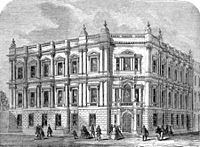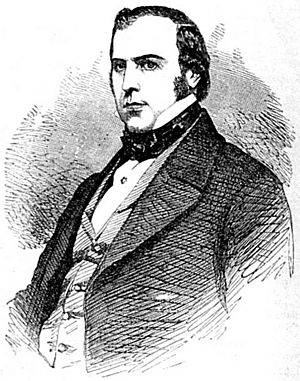Metropolitan Board of Works facts for kids
Quick facts for kids Metropolitan Board of Works |
|
|---|---|
 |
|
| Type | |
| Type |
Board of works
|
| Houses | Unicameral |
|
Term limits
|
Three years |
| History | |
| Founded | December 1855 |
| Disbanded | March 1889 |
| Preceded by | |
| Succeeded by | London County Council, the (District of the) Metropolis being renamed the County of London |
| Leadership | |
|
Chairman
|
|
| Structure | |
| Seats |
|
| Committees |
|
|
Length of term
|
Three years, with one third of board appointed every year |
| Elections | |
| Indirect election | |
| Meeting place | |
 |
|
| Spring Gardens (1859–1889) | |
The Metropolitan Board of Works (MBW) was a special group that helped manage London from 1855 to 1889. Its main job was to improve London's buildings and services as the city grew very fast. The MBW also created and looked after many important parks and open spaces.
This board served a large area around the old City of London. This area included parts of Middlesex, Surrey, and Kent. The MBW worked for 33 years until a new system of local government was created.
The MBW was formed by the Metropolis Management Act 1855. This law replaced older groups that handled buildings and sewers. The MBW was later replaced by the London County Council in 1889.
The MBW faced challenges because its members were not directly chosen by the public. They were picked by local groups called vestries. This meant the board was not always directly answerable to the people. Also, there were some problems with how money was handled. Despite these issues, the MBW showed how useful it was to have one big group manage services like street lighting, fire fighting, and transport for a large city.
Contents
Why London Needed the MBW
London was growing incredibly fast during the 1800s. The British Empire was expanding, and trade was booming at the London Docks. More people moved to the city, needing more homes and services.
However, managing this huge city was difficult. Over 100 different groups had power, and their areas often overlapped. This made it hard to get things done, like building new roads or improving services.
Most major cities in Britain had elected local governments by 1835. But London was different. The City of London kept its old boundaries and did not want to include the new, poorer areas around it. This meant that different local officials and groups managed the growing city.
In 1837, there was an idea to create one elected group for all of London. But wealthier areas like Marylebone and Westminster did not agree. They worried about losing their local powers and having to pay more taxes. So, the idea failed. In 1854, another plan suggested dividing London into seven areas, each with a representative on a new board. This plan also changed, but it led to the creation of the MBW the very next year.
How the MBW Was Created
To help London grow in an organized way, Parliament passed the Metropolis Management Act 1855. This law created the Metropolitan Board of Works. The MBW took over the jobs of earlier groups that managed buildings and sewers. The area it covered was called "the Metropolis," which was the London area defined in the 1851 census.
The MBW was not chosen by direct public vote. Instead, its members were nominated by local authorities called vestries. Larger vestries chose two members, and the City of London chose three. Some smaller areas joined together to pick their members. In total, there were 45 members. These members then chose a Chairman.
The first members were nominated in December 1855. The Board held its first meeting on December 22, 1855. At this meeting, John Thwaites was chosen as the first chairman. The MBW officially started its work on January 1, 1856.
What the MBW Did for London
Improving London's Sewers
One of the biggest problems in London was sewage. Most of the city's waste flowed directly into the Thames River. This caused a terrible smell, especially in summer. The summer of 1858 was so bad it was called "The Great Stink".
A major success of the MBW was building a modern London sewerage system. This huge project included 75 miles (120 km) of main sewers and 1000 miles (1650 km) of street sewers. This system greatly improved public health and solved the "Great Stink" problem. Much of this work was led by the MBW's Chief Engineer, Joseph Bazalgette.
Building New Streets and Bridges
The MBW also worked on clearing crowded areas and building new streets to ease traffic. Important new streets included Charing Cross Road, Southwark Street, and Shaftesbury Avenue.
From 1869, the MBW bought all the private bridges over the Thames within its area. It then removed the tolls, making it free for people to cross. The board also rebuilt several bridges, such as Putney Bridge, Battersea Bridge, and Hammersmith Bridge.
The board also wanted to build a new bridge east of London Bridge. Engineer Bazalgette drew up plans for a bridge that would cost about £1.25 million. However, the government did not provide enough money, and the plans for this bridge were not approved by Parliament at the time.
Creating the Thames Embankment
The MBW also funded the building of the Thames Embankment starting in 1864. This project, designed by Joseph Bazalgette, created tree-lined walkways along the river. It also helped manage the river's flow and provided space for new sewers.
Starting the Fire Brigade
From 1865, the MBW became responsible for managing the Metropolitan Fire Brigade. Architects working for the MBW designed new fire stations, like Fulham Fire Station.
Developing Parks and Open Spaces
In 1856, the MBW gained the power to create "parks, pleasure-grounds and open spaces." They acquired or developed many important green areas, including:
- Finsbury Park (opened 1869)
- Southwark Park (opened 1869)
- Victoria Embankment Gardens (opened 1870)
- Leicester Square (opened 1874)
- Wormwood Scrubs (acquired 1879)
- Hampstead Heath (acquired 1886)
- Battersea Park, Kennington Park, and Victoria Park (taken over in 1887)
- Clapham Common (transferred 1887)
- Wandsworth Common (transferred 1887)
- Ravenscourt Park (1888) and Clissold Park (1889)
- Dulwich Park (opened by the London County Council in 1890, but laid out by MBW)
The MBW also worked to protect common lands in London, like Streatham Common and Tooting Common. This ensured that the public could continue to use these open spaces.
How the MBW Was Organized
The MBW first met in the Guildhall of the City of London. Its main office was on Greek Street in Soho. Later, it built its own headquarters at Spring Gardens in 1859. This building was designed by its first chief architect, Frederick Marrable.
When John Thwaites, the first chairman, passed away in 1870, James Macnaghten Hogg took over. He remained chairman until the MBW was closed down. In 1885, the number of members on the board increased to 59.
Why the MBW Was Abolished
The Metropolitan Board of Works was eventually replaced by the London County Council (LCC). The LCC was elected on January 21, 1889, and was set to take over on April 1.
In its final weeks, the MBW made some decisions that the new LCC disagreed with. For example, the MBW started giving large pensions to its retiring staff and high salaries to those who would move to the new council. The MBW also made a decision about a hospital's use of pavement space, which the LCC opposed. The MBW ignored the LCC's requests to wait.
Finally, the MBW decided to award a contract for the Blackwall Tunnel at its very last meeting. The LCC again asked them to leave the decision to the new council. The MBW chairman replied that they would continue. Because of this, the LCC asked the government to step in. The government then officially abolished the MBW and brought the LCC into existence on March 21, 1889.
The magazine Punch even published a cartoon about the MBW's end. It suggested that the MBW was known for unfair dealings.
The MBW's old headquarters near Admiralty Arch were taken over by the LCC until their new building, County Hall, was finished in 1922. The old building was later demolished in 1971.
Chairmen of the MBW
- Sir John Thwaites (1855–1870)
- James Macnaghten Hogg (1870–1889)
Images for kids





